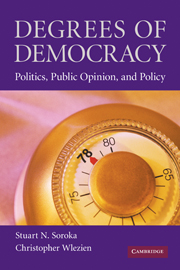Book contents
- Frontmatter
- Contents
- Preface
- Degrees of Democracy
- 1 Public Opinion and Policy in Representative Democracy
- 2 The Thermostatic Model
- 3 Adding Issues and Institutions
- 4 Public Preferences and Spending
- 5 Parameters of Public Responsiveness
- 6 Public Responsiveness Explored
- 7 Policy Representation
- 8 Disaggregating Public Responsiveness and Policy Representation
- 9 Degrees of Democracy
- Appendix
- Bibliography
- Index
Appendix
Published online by Cambridge University Press: 05 June 2012
- Frontmatter
- Contents
- Preface
- Degrees of Democracy
- 1 Public Opinion and Policy in Representative Democracy
- 2 The Thermostatic Model
- 3 Adding Issues and Institutions
- 4 Public Preferences and Spending
- 5 Parameters of Public Responsiveness
- 6 Public Responsiveness Explored
- 7 Policy Representation
- 8 Disaggregating Public Responsiveness and Policy Representation
- 9 Degrees of Democracy
- Appendix
- Bibliography
- Index
Summary
This appendix includes information on data sources, descriptives for the preferences and spending data used through the book (Appendix Table 1), as well as detailed regression results for all preceding models of public responsiveness (Appendix Table 2) and policy representation (Appendix Table 3).
For Appendix Tables 2 and 3, regression results are shown in the order in which they appear in the text. In each case, regression models are also preceded by a reference to the table in the text in which the abbreviated results appear. The first models in Appendix Table 2 appear in Table 5.2 of the text, for instance; the first models in Appendix Table 3 appear in Table 7.2. In cases where only certain domains appear in the main text but models were estimated for other domains, they too are included under the relevant table heading.
DATA SOURCES
Public Preferences
Net preferences for policy are measured using questions about government spending, and both the question wording and the “net support” measure are described in detail in Chapter 4. The General Social Survey, from which we draw the U.S. data, is available from the National Opinion Research Archive (NORC) at the University of Chicago. Aggregate results from U.K. Gallup are available in King and Wybrow (2001); for Chapter 8, where preferences are broken down by sub-group, we rely on the U.K. Gallup surveys available from the Roper Center for Public Opinion Research.
- Type
- Chapter
- Information
- Degrees of DemocracyPolitics, Public Opinion, and Policy, pp. 183 - 218Publisher: Cambridge University PressPrint publication year: 2009

